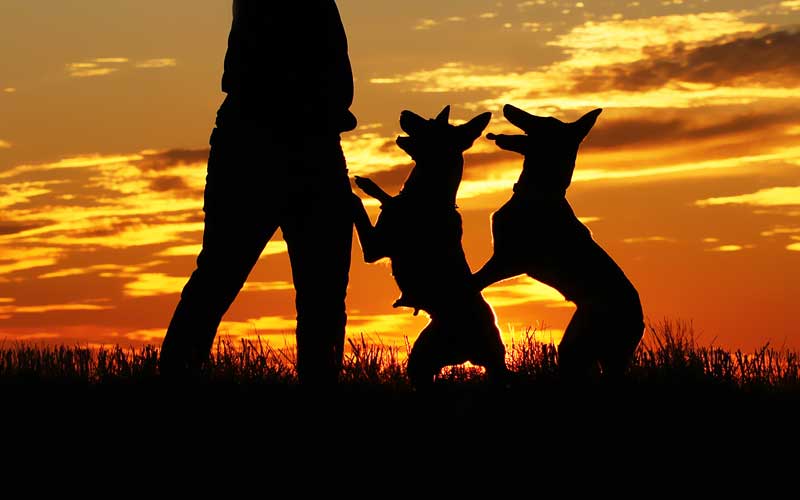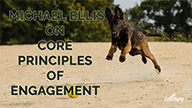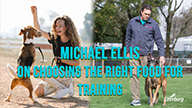Tips on Living with High Energy Dogs

The alarm goes off at 5:30am…BEEP! BEEP! BEEP! My face, still buried in the pillow, reluctantly rises just enough to allow my arm to reach out in desperation to hit the snooze button.
There. Peace.
Moments later, “Yip, yip, yip!” goes the new client's dog. This is the story of my life when it comes to checking in a new puppy (or even older dog) to my resident training program. As I begrudgingly drag myself out of bed, stuff my feet into flip flops, and fasten a robe around my waist in utter grumpiness, the yipping escalates, and the dog is now like a tornado. The crate is actually rocking back and forth in MayTag washing machine fashion. By the time I am able to unlatch the crate door, Fluffy has now turned into a Tasmanian Devil cartoon character, jumping, spinning, hair flying. If I am lucky I will avoid a bump to the lip.
By the time the new training dog (aka “The Heathen”) is taken outside to potty, the rest of the household is now awake and ready to rumble. I have officially started the day off as a bonafide grouch. Only freshly ground and brewed Italian roast coffee will bring joy to life in this moment. I finish nursing my mug of steaming coffee bliss as I finish dog rotations.
It may not be terribly difficult to imagine this scenario. In fact, this is the root of many client frustrations I experience as a professional dog trainer and coach. Many of my new clients with super high energy, destructive dogs often admit to me that they attempted some sort of management/containment training with their dog, but not seeing the light at the end of the tunnel, and losing copious amounts of sleep, they gave up. Somehow, this started the slide down the slippery slope where the dog was then allowed to sleep loose, which led to destructive behavior or accidents. So the dog was put outside more to “burn off energy”, which led to barking dog complaints by the neighbor, barrier frustration, and so on. So, the client attempted to walk the dog, only to be further frustrated by a barking, unruly dragon at the end of the leash.
Never fear. It all goes back to basics first. While your new issue may be leash walking, it likely all stems with energy and behavior management around the home. By creating an energy burn plan for your energetic pooch in conjunction with training, you can get that adorable, furry monster under control. Here are some tips to help you out:
Tip 1: A Tired Dog is a Good Dog
A tired dog is a good dog! A treadmill is a GREAT way to burn off a little extra energy before bedtime, on rainy days, or when you simply have a dog who needs a little extra burn before their daily excursions. I WALK my dogs predominantly on the treadmill. The idea is not to get their fitness level so high that it exceeds your energy level, but to burn off a bit of energy in a slow, controlled fashion. Twenty minutes of “walkie time” as I call it on a treadmill will prepare you and your dog for a more enjoyable hike later in the day. Think of it as a warm up. You might add five minutes of trotting to get the tongue lolling, but mostly calm walking is best to condition a relaxed mind.
Tip 2: Teach Your Dog Patience
Teach your dog the concept of patience. We tend to go places. We always have a destination. In horse training there is a method of tying a horse on what is called a patience pole. They simply learn the skill of doing nothing for long periods affixed to a pole sunk in the ground. In dog training, your dog needs to learn to be patient and relaxed while on leash. YOU can be the patience pole. If it can be done with a thousand pound animal, surely we can teach Fido to just wait. Do nothing. Go no where. Coffee shop patios are great for this. Also, teach your dog to be patient and travel in a crate. They exit the vehicle calmer in most cases and allow you to get your equipment organized before the dog exits the vehicle so you aren't in a mad rush. If you are rushing because your dog is wound up, who is in the driver's seat?
Tip 3: Make a Training Box
Get the equipment to help you accomplish these things. Make a training box or bag. Training leashes, collars, Bitter Apple Spray for barking, squirt bottles, treats are all part of my training box. You may need a pro to help you properly implement their use and perfect techniques, but without the right gear you are wasting your time.
Tip 4: Double Up with Exercise + Patience
Pick three to four activities lasting an hour or more to do with your dog each week to burn exercise, then practice being a patience pole during that activity for 15 of those minutes. Hiking, biking, trip to the beach or lake, field trip to Petsmart or Home Depot, etc. Don't wait to do your training until you have to make a vet appointment, or when your child is playing in a soccer game. Practice before you need the skills. With a high-energy dog, you may need to treadmill before you engage in these activities to manage their enthusiasm.
Tip 5: Enrichment Treats
Enrichment treats such as bones with frozen peanut butter on the inside, stuffed Kongs, knuckle bones, bully sticks, and pig ears are all example of some great enrichment items to create calmness while inside the home, kennel, or crate.
Conclusion
So, stock up your training bag. Get a strategy in place to pre-burn some energy BEFORE your dog excursion, and schedule your weekly field trips. Put a plan in place and try it for two weeks and you will see a big difference in your dog's behavior.
Who knows? You might even want to go to the next level and enroll in more challenging courses for fun!









Ask Cindy.